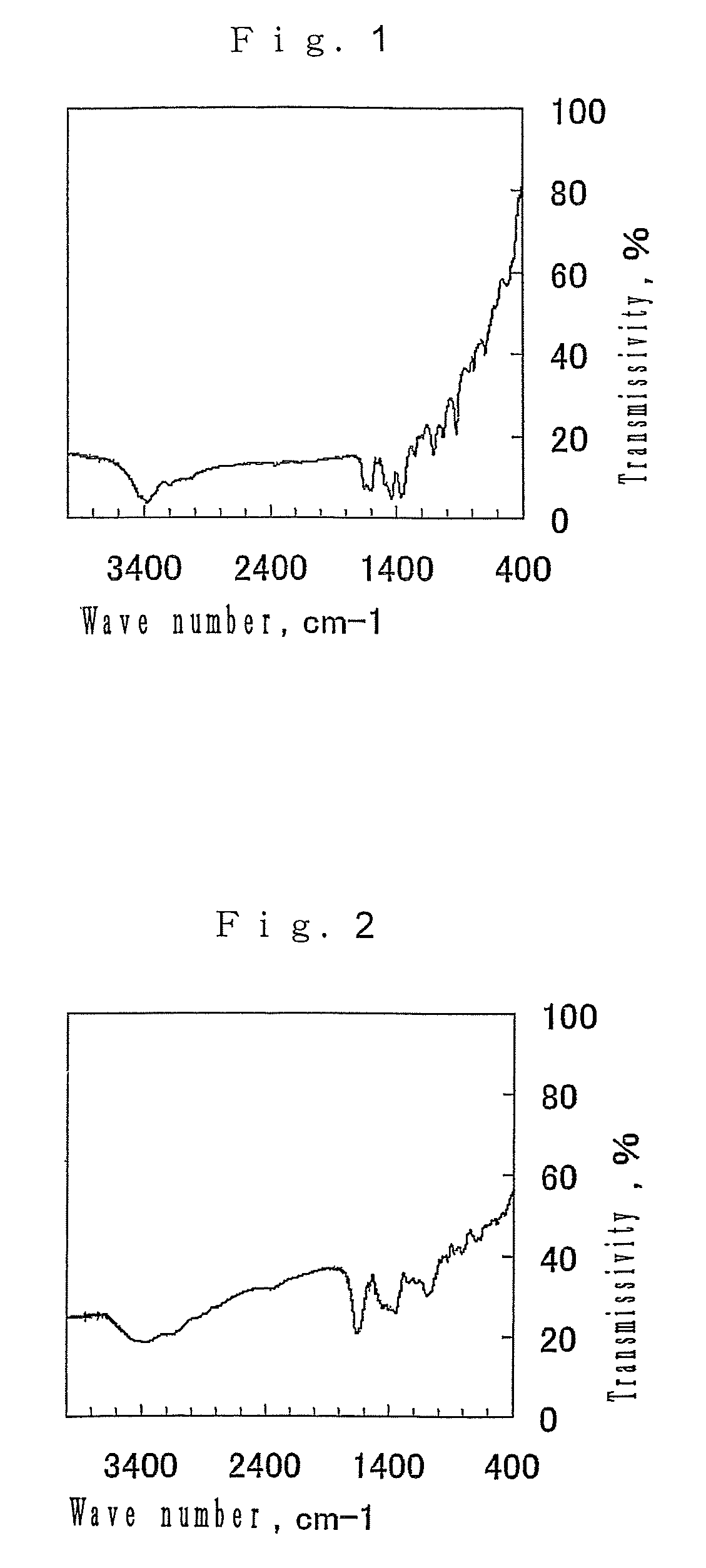Porous substance and process for producing the same
a porous substance and process technology, applied in the field of porous substances, can solve the problems of difficult storage and transportation of hydrogen gas, difficult to store or transport hydrogen gas, and limitation in industrial views to produce porous substances at a low production cost. , to achieve the effect of producing porous substances on a large scale, excellent gas absorption, and high-developed pore structur
- Summary
- Abstract
- Description
- Claims
- Application Information
AI Technical Summary
Benefits of technology
Problems solved by technology
Method used
Image
Examples
example 1
(1) Synthesis of 1,3,5-triaminobenezen-borane Adduct
[0062]2.46 g of 1,3,5-triaminobenzene were mixed with 200 mL of tetrahydrofuran (dehydration) and heated to a temperature of 80° C. under a nitrogen flow to be dissolved. To the resulting solution while being cooled in an ice bath were added gradually dropwise 60 mL of 1.0 M borane tetrahydrofuran complex. After the mixture was stirred at room temperature for one hour, it was vacuum-dried, cooled in a dry ice / acetone bath, thereby obtaining 3.2 g of 1,3,5-triaminobenzene-borane adduct in the form of brownish residual.
(2) Production of a Porous Substance
[0063]Dehydrogenation was carried out by heating 500 mg of the resulting 1,3,5-triaminobenzene-borane adduct at a temperature of 100° C. under a nitrogen atmosphere. After foaming was over, vacuum-evacuation was carried out at a temperature of 100° C.
[0064]FIG. 1 shows the infrared absorption spectrum of the resulting porous substance. As the result of analysis of the spectrum, it wa...
example 2
[0066]The porous substance produced in Example 1 was calcined at a temperature of 600° C. under a nitrogen flow for two hours. As the result of measurement of the BET surface area of the calcined product by a nitrogen adsorption method, it was confirmed that the BET surface area was 23 m2 / g.
[0067]Thereafter, the hydrogen absorbability of the calcined product was evaluated by a volumetric analysis. Before the evaluation, the porous substance was treated in vacuo at a temperature of 100° C. for two hours. After the pressure was increased to 9.5 MPa at room temperature to measure the hydrogen absorbability, the substance absorbed 0.35 percent by mass of hydrogen.
example 3
(1) Synthesis of 2,4,6-triaminopyrimidine-borane Adduct
[0068]0.6 g of 2,4,6-triaminopyrimidine was mixed with 200 mL of 1-methyl-2-pyrrolidone (dehydration) and heated to a temperature of 80° C. under a nitrogen flow to be dissolved. To the resulting solution while being cooled in an ice bath were added gradually dropwise 30 mL of 1.0 M borane tetrahydrofuran complex. After the mixture was stirred at room temperature for one hour, followed by heating to a temperature of 60° C. and then stirring for two hours, a large amount of precipitate was produced. The reaction solution was subjected to suction filtration to collect the precipitate, which was then vacuum-dried at a temperature of 60° C. for 8 hours thereby obtaining 0.7 g of 2,4,6-triaminopyrimidine-borane adduct in the form of brownish residue.
(2) Production of a Porous Substance
[0069]Dehydrogenation was carried out by heating 500 mg of the resulting 2,4,6-triaminopyrimidine adduct at a temperature of 100° C. in vacuo for 8 hou...
PUM
| Property | Measurement | Unit |
|---|---|---|
| temperature | aaaaa | aaaaa |
| pressure | aaaaa | aaaaa |
| temperature | aaaaa | aaaaa |
Abstract
Description
Claims
Application Information
 Login to View More
Login to View More - R&D
- Intellectual Property
- Life Sciences
- Materials
- Tech Scout
- Unparalleled Data Quality
- Higher Quality Content
- 60% Fewer Hallucinations
Browse by: Latest US Patents, China's latest patents, Technical Efficacy Thesaurus, Application Domain, Technology Topic, Popular Technical Reports.
© 2025 PatSnap. All rights reserved.Legal|Privacy policy|Modern Slavery Act Transparency Statement|Sitemap|About US| Contact US: help@patsnap.com



